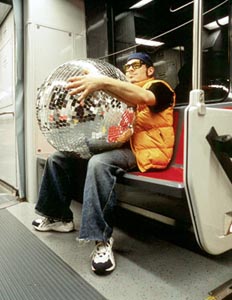![[Metroactive Movies]](/movies/gifs/movies468.gif)
[ Movies Index | Show Times | San Jose | Metroactive Central | Archives ]
 The Ecstasy and the Ecstasy: Dimitri of the Lower Haight shows up for an all-night rave in 'Groove.'
The Ecstasy and the Ecstasy: Dimitri of the Lower Haight shows up for an all-night rave in 'Groove.'
Rave Form Greg Harrison's 'Groove' follows an SF rave from dusk to dawn THE MOVIE Groove, a dusk-to-dawn picture with a short prologue and epilogue, presents rave culture in an affectionate light. Greg Harrison's film concerns the staging of a illegal night-long dance at a remote San Francisco warehouse. We see how the organizers break into an abandoned building, tap into the power supply and set up loudspeakers. Celebrity DJs arrive for their shifts with crates of records to create an unbroken wall of sound. The big guest star, heavily lionized by the script, is DJ Digweed. Of the other record-spinners, including Snaz and Forest Green, only DJ Polywog has real star potential. This quirky blonde with an Elvisine scowl should have had more scenes. As for the musical differences between the DJs, I was deaf to it--I was in the position of listening to an Inuit explaining the variations in the 90 different qualities of snow. Some things, however, never change. That combination of drugs, loud music and desire for escape and communion has been around a long time now. Groove has a musical's true, skimpy plot. David (Hamish Linklater), newly arrived in San Francisco from Michigan, is nervous about what a rave entails. His brother, Colin (Denny Kirkwood), more experienced, has just announced his engagement to Harmony (Mackenzie Firgens). At the rave, the three carom off other characters: Leyla (Lola Glaudini), who starts to spend the evening with David, and Anthony (Vince Riverside), a cruiser surveying this touchy-feely scene with something more basic in mind than just merging consciousnesses. The quickness and lightness of Groove recommend it, along with Linklater's and Glaudini's touching performances. Groove has a sense of humor about rave culture--and that humor isn't easy to muster about a scene infused with psychedelics and besieged by the police. Lines like "If you get past the Tickle-Me Elmo backpacks and the floppy cloth plants, some of these girls'd be cute" show that Harrison hasn't taken the scene with fatal seriousness. Still, the lightness of Groove can turn against it at times. David's and Leyla's big problems, we learn, are their stalemated careers, not their emotions. Groove doesn't stumble over the big issues, because it never reaches for anymore than the little ones. I doubt if anyone lured to this movie will care about the drug use, though the press notes try to calm the squares with prose worthy of the antidrug pamphlets: "Some people who go to raves seek the enhancement of illegal drugs like Ecstasy, LSD and GHB." Groove may not want to glamorize drugs--how could you stand that racket without drugs?--but pretty much everyone takes something to make it through the night. ("I'd rather bake than fry," says one character turning down Ecstasy in favor of marijuana.) Mostly what appeals in Groove is the argument that this rave culture is a self-fermented scene. The film persuades one that raves are a countercultural effort to make something out of nothing, to bring a crowd together for something more special than money.
Groove (R; 86 min.), directed and written by Greg Harrison, photographed by Matthew Irving and starring Hamish Linklater, Denny Kirkwood and Lola Glaudini, opens Friday at Camera Three in San Jose and the Square in Palo Alto. [ San Jose | Metroactive Central | Archives ]
|
From the June 8-14, 2000 issue of Metro, Silicon Valley's Weekly Newspaper.
Copyright © 2000 Metro Publishing Inc. Metroactive is affiliated with the Boulevards Network.
For more information about the San Jose/Silicon Valley area, visit sanjose.com.